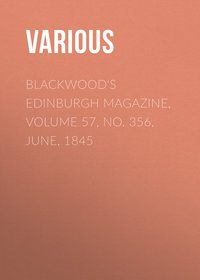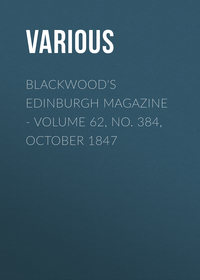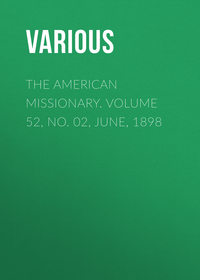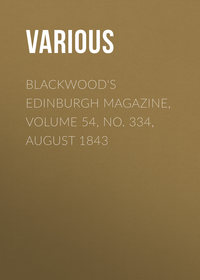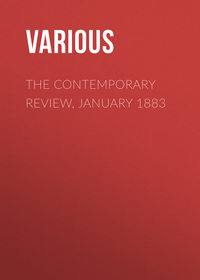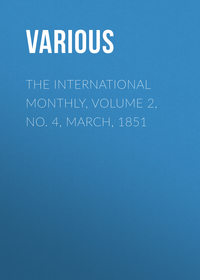 полная версия
полная версияChambers's Edinburgh Journal, No. 442
This explanation by Mr Warrington from scientific data, is confirmed by Mr Fortune from personal observation, and fully accounts, not only for the difference in colour between the two teas, but also for the effect produced on some constitutions by green tea, such as nervous irritability, sleeplessness, &c.; and Mr Fortune truly remarks, that what Mr Warrington observed in the laboratory of Apothecaries' Hall, may be seen by every one who has a tree or bush in his garden. Mark the leaves which are blown from trees in early autumn; they are brown, or perhaps of a dullish green when they fall, but when they have been exposed for some time in their detached state to air and moisture, they become as black as our blackest teas. Without detailing the whole process in the manufacture of either kind of tea, it may be stated in reference to green tea, 1st, That the leaves are roasted almost immediately, after they are gathered; and 2d, That they are dried off quickly after the rolling process. In reference to black tea, on the other hand, it may be observed, 1st, That after being gathered, the leaves are exposed for a considerable time; 2d, That they are tossed about until they become soft and flaccid, and are then left in heaps; 3d, That after being roasted for a few minutes and rolled, they are exposed for some hours to the air in a soft and moist state; and 4th, That they are at last dried slowly over charcoal fires. After all, then, genuine green tea is, as might reasonably be conjectured, an article less artificial than black. There is, at the same time, too much foundation for the suspicion, that the green teas so much patronised in Europe and America, are not so innocently manufactured. Mr Fortune witnessed the process of colouring them in the Hung-chow green-tea country, and describes the process. The substance used is a powder consisting of four parts of gypsum and three parts of Prussian blue, which was applied to the teas during the last process of roasting.
'During this part of the operation,' he says, 'the hands of the workmen were quite blue. I could not help thinking, that if any green-tea drinkers had been present during the operation, their taste would have been corrected, and, I may be allowed to add, improved. One day, an English gentleman in Shang-hae, being in conversation with some Chinese from the green-tea country, asked them what reasons they had for dyeing the tea, and whether it would not be better without undergoing this process. They acknowledged that tea was much better when prepared without having any such ingredients mixed with it, and that they never drank dyed teas themselves; but justly remarked, that as foreigners seemed to prefer having a mixture of Prussian blue and gypsum with their tea, to make it look uniform and pretty, and as these ingredients were cheap enough, the Chinese had no objections to supply them, especially as such teas always fetched a higher price!' The quantity of colouring matter used is rather more than an ounce to 14½ lbs. of tea; so that in every 100 lbs. of coloured green tea consumed in England or America, the consumer actually drinks nearly half a pound of Prussian blue and gypsum! Samples of these ingredients, procured from the Chinamen in the factory, were sent last year to the Great Exhibition.
In the black-tea districts, as in the green, large quantities of young plants are yearly raised from seeds. These seeds are gathered in the month of October, and kept mixed up with sand and earth during the winter months. In this manner they are kept fresh until spring, when they are sown thickly in some corner of the farm, from which they are afterwards transplanted. When about a year old, they are from nine inches to a foot in height, and ready for transplanting. This is always done at the change of the monsoon in spring, when fine warm showers are of frequent occurrence. The most favourable situations are on the slopes of the hills, as affording good drainage, which is of the utmost importance; and which, on the plains, is attained by having the lands above the watercourses. Other things being equal, a moderately rich soil is preferred. They are planted in rows about four feet apart (in poor soils, much closer), and have a very hedge-like appearance when full grown. A plantation of tea, when seen at a distance, looks like a little shrubbery of evergreens. As the traveller threads his way amongst the rocky scenery of Woo-e-shan, he is continually coming upon these plantations, which are dotted upon the sides of all the hills. The leaves are of a rich dark-green, and afford a pleasing contrast to the strange, and often barren scenery which is everywhere around. The young plantations are generally allowed to grow unmolested for two or three years, till they are strong and healthy; and even then, great care is exercised not to exhaust the plants by plucking them too bare. But, with every care, they ultimately become stunted and unhealthy, and are never profitable when they are old; hence, in the best-managed tea-districts, the natives yearly remove old plantations, and supply their places with fresh ones. About ten or twelve years is the average duration allowed to the plants. The tea-farms are in general small, and their produce is brought to market in the following manner: A tea-merchant from Tsong-gan or Tsin-tsun, goes himself, or sends his agents, to all the small towns, villages, and temples in the district, to purchase teas from the priests and small farmers. When the teas so purchased are taken to his house, they are mixed together, of course keeping the different qualities as much apart as possible. By this means, a chop (or parcel) of 600 chests is made; and all the tea of this chop is of the same description or class. The large merchant in whose hands it is now, has to refine it, and pack it for the foreign market. When the chests are packed, the name of the chop is written upon each, or ought to be; but it is not unusual to leave them unmarked till they reach the port of exportation, when the name most in repute is, if possible, put upon them. When the chop is purchased in the tea-district, a number of coolies are engaged to carry the chests on their shoulders, either to their ultimate destination, or to the nearest river. The time occupied in the entire transport by land and river, from the Bohea country to Canton, is about six weeks or two months. The expenses of transit, of course, vary with localities, and other circumstances; but, in general, those expenses are so very moderate, that the middlemen realise large profits, while the small farmers and manipulators are subjected to a grinding process, which keeps them in comparative poverty.
Of late years, some attempts have been made to cultivate the tea-shrub in America and Australia; but the result will not equal the expectation entertained by the projectors of the scheme. The tea-plant will grow wherever the climate and soil are suitable; but labour is so much cheaper in China than in either of those countries, that successful competition is impossible. The Chinese labourers do not receive more than twopence or threepence a day. The difference, therefore, in the cost of labour will afford ample protection to the Chinese against all rivals whose circumstances in this respect are not similar to their own.
India, however, is as favourably situated in all respects for tea-cultivation as China itself, and its introduction, therefore, into that country is a matter of equal interest and importance. In procuring the additional seeds, implements, and workmen, Mr Fortune succeeded beyond his expectations. Tea-seeds retain their vitality for a very short period, if they are out of the ground; and after trying various plans for transporting them to their destination, he adopted the method of sowing them in Ward's cases soon after they were gathered, which had the effect of preserving them in full life. The same plan will answer as effectually in preserving other kinds of seeds intended for transportation, and in which so much disappointment is generally experienced. In due time, all the cases arrived at their destination in perfect safety, and were handed over to Dr Jameson, the superintendent of the botanical gardens in the north-west provinces, and of the government tea-plantations. When opened, the tea-plants were found to be in a very healthy state. No fewer than 12,838 plants were counted, and many more were germinating. Notwithstanding their long voyage from the north of China, and the frequent transhipment and changes by the way, they seemed as green and vigorous as if they had been growing all the while on the Chinese hills.
In these days, when tea is no longer a luxury, but a necessary of life in England and her colonies, its production on Indian soil is worthy of persevering effort. To the natives of India themselves, it would be of the greatest value. The poor paharie, or hill-peasant, has scarcely the common necessaries of life, and certainly none of its luxuries. The common sorts of grain which his lands produce will scarcely pay the carriage to the nearest market-town, far less yield such a profit as to enable him to procure any articles of commerce. A common blanket has to serve him for his covering by day and for his bed at night, while his dwelling-house is a mere mud-hut, capable of affording but little shelter from the inclemency of the weather. If part of these lands produced tea, he would then have a healthy beverage to drink, besides a commodity which would be of great value in the market. Being of small bulk, and extremely light in proportion to its value, the expense of carriage would be trifling, and he would have the means of making himself and his family more comfortable and more happy. In China, tea is one of the necessaries of life, in the strictest sense of the word. A Chinese never drinks cold water, which he abhors, and considers unhealthy. Tea is his favourite beverage from morning to night—not what we call tea, mixed with milk and sugar—but the essence of the herb itself drawn out in pure water. Those acquainted with the habits of the people, can scarcely conceive of their existence, were they deprived of the tea-plant; and there can be no doubt that its extensive use adds much to their health and comfort. The people of India are not unlike the Chinese in many of their habits. The poor of both countries eat sparingly of animal food; rice, and other grains and vegetables, form the staple articles on which they live. This being the case, it is not at all unlikely that the Indian will soon acquire a habit which is so universal in China. But in order to enable him to drink tea, it must be produced at a cheap rate, not at 4s. or 6s. a pound, but at 4d. or 6d.; and this can be done, but only on his own hills. The accomplishment of this would be an immense boon for the government to confer upon the people, and might ultimately work a constitutional change in their character and temperament—ridding them of their proverbial indolence, and endowing them with that activity of body and mind which renders the Chinese so un-Asiatic in their habits and employments.
That our readers may, if they choose, have 'tea as in China,' we quote a recipe from a Chinese author, which may be of service to them. 'Whenever the tea is to be infused for use,' says Tüng-po, 'take water from a running stream, and boil it over a lively fire. It is an old custom to use running water boiled over a lively fire; that from springs in the hills is said to be the best, and river-water the next, while well-water is the worst. A lively fire is a clear and bright charcoal fire. When making an infusion, do not boil the water too hastily, as first it begins to sparkle like crabs' eyes, then somewhat like fish's eyes, and lastly, it boils up like pearls innumerable, springing and waving about. This is the way to boil the water.' The same author gives the names of six different kinds of tea, all of which are in high repute. As their names are rather flowery, they may be quoted for the reader's amusement. They are these: the 'first spring tea,' the 'white dew,' the 'coral dew,' the 'dewy shoots,' the 'money shoots,' and the 'rivulet garden tea.' 'Tea,' says he, 'is of a cooling nature, and, if drunk too freely, will produce exhaustion and lassitude. Country people, before drinking it, add ginger and salt, to counteract this cooling property. It is an exceedingly useful plant; cultivate it, and the benefit will be widely spread; drink it, and the animal spirits will be lively and clear. The chief rulers, dukes, and nobility, esteem it; the lower people, the poor and beggarly, will not be destitute of it; all use it daily, and like it.' Another author upon tea says, that 'drinking it tends to clear away all impurities, drives off drowsiness, removes or prevents headache, and it is universally in high esteem.'
THE GREAT OYER OF POISONING
In a previous article, an account was given of the proceedings against the Earl and Countess of Somerset for the murder of Sir Thomas Overbury. Though they were spared, several other persons were executed for this offence; and the circumstances under which those who were represented as the chief criminals escaped, while the others, whose guilt was represented as merely secondary, were executed, is among the most mysterious parts of the history. There was so much said about poisoning throughout the whole inquiry, that Sir Edward Coke gave the trials the name of 'The Great Oyer of Poisoning.' Oyer has long been a technical term in English law; and it is almost unnecessary to explain, that it is old French for to hear—oyer and terminer meaning, to hear and determine. The same inscrutable reasons which make the evidence so imperfect against the chief offenders, affect the whole of it. But while the exact causes of the death of Sir Thomas Overbury may be left in doubt, as well as the motives which led to it, enough is revealed in the trials of the minor offenders to throw a remarkable light on the strange habits of the time, and especially on the profligacy and credulity of the court of King James.
The first person put to trial was Richard Weston, who had been appointed for the purpose of taking charge of Sir Thomas Overbury. If he had been murdered by poison, there could be no doubt that Weston was one of the perpetrators. He had been brought up as an apothecary; and it was said that he was selected on account of his being thus enabled to dabble in poisons. The charge against him is very indistinct. He was charged that he, 'in the Tower of London, in the parish of Allhallows Barking, did obtain and get into his hand certain poison of green and yellow colour, called rosalgar—knowing the same to be deadly poison—and the same did maliciously and feloniously mingle and compound in a kind of broth poured out into a certain dish.' Weston long refused to plead to the indictment. Of old, a person could not be put on trial unless he pleaded not guilty, and demanded a trial. The law, however, provided for those who were obstinate a more dreadful death than would be inflicted on the scaffold. To frighten him into compliance, the court gave him a description of it, telling him that he was 'to be extended, and then to have weights laid upon him no more than he was able to bear, which were by little and little to be increased; secondly, that he was to be exposed in an open place near to the prison, in the open air, being naked; and lastly, that he was to be preserved with the coarsest bread that could be got, and water out of the next sink or puddle.' He was told that 'oftentimes men lived in that extremity eight or nine days.' People have sometimes endured the peine forte et dure, as it was called, because, unless they pleaded and were convicted, their estates were not forfeited; and they endured the death of protracted torture for the sake of their families. Weston's object was supposed to be to prevent a trial, the evidence in which would expose his great patrons the Earl and Countess of Somerset. The motive was not, however, strong enough to make him stand to his purpose. He pleaded to the indictment, was found guilty, and executed at Tyburn.
The next person brought up was of a more interesting character—Anne Turner, the widow of a physician. It is stated in the Report, that when she appeared at the bar, the chief-justice Coke said to her: 'that women must be covered in the church, but not when they are arraigned, and so caused her to put off her hat; which done, she covered her hair with her handkerchief, being before dressed in her hair with her handkerchief over it.' Although Mother Turner's pursuits were of the questionable kind generally attributed to old hags—she dealt in philters, soothsaying, and poisoning—she must have been a young and beautiful woman. In some of the letters which were produced at the trials, she was called 'Sweet Turner.' In a poem, called Overbury's Vision, published in 1616, and reprinted in the seventh volume of the Harleian Miscellany, she is thus enthusiastically described—
'It seemed that she had been some gentle dame;For on each part of her fair body's frameNature such delicacy did bestow,That fairer object oft it doth not shew.Her crystal eye, beneath an ivory brow,Did shew what she at first had been; but nowThe roses on her lovely cheeks were dead;The earth's pale colour had all overspreadHer sometime lovely look; and cruel Death,Coming untimely with his wintry breath,Blasted the fruit which, cherry-like in show,Upon her dainty lips did whilome grow.Oh, how the cruel cord did misbecomeHer comely neck! And yet by law's just doomHad been her death.'It might be said to be Mrs Turner's profession, to minister to all the bad passions of intriguers. The wicked Countess of Essex employed her to secure to her, by magic arts and otherwise, the affection of Somerset, and at the same time to create alienation and distaste on the part of her husband. Among the documents produced at her trial was one said to be a list of 'what ladies loved what lords;' and it is alleged that Coke prohibited its being read, because, whenever he cast his eye on it, he saw there the name of his own wife. Some mysterious articles were produced at the trial, which were believed to be instruments of enchantment and diabolical agency. 'There were also enchantments shewed in court, written in parchment, wherein were contained all the names of the blessed Trinity mentioned in the Scriptures; and in another parchment + B + C + D + E; and in a third, likewise in parchment, were written all the names of the holy Trinity, as also a figure, on which was written this word, corpus; and on the parchment was fastened a little piece of the skin of a man. In some of these parchments were the devil's particular names, who were conjured to torment the Lord Somerset, and Sir Arthur Manwaring, if their loves should not continue, the one to the Countess, the other to Mrs Turner.' Along with these were some pictures, as they were termed, or, more properly speaking, models of the human figure. 'At the shewing,' says the report, 'of these, and inchanted papers, and other pictures in court, there was heard a crack from the scaffolds, which caused great fear, tumult, and confusion among the spectators, and throughout the hall, every one fearing hurt, as if the devil had been present, and grown angry to have his workmanship shewed by such as were not his own scholars.'4
The small figures, which appeared to have created the chief consternation, were, we are inclined to believe, very innocent things. There was, it is true, a belief that an individual could be injured or slain by operations on his likeness. There was, however, another purpose connected with Mrs Turner's pursuits to which small jointed images, like artists' lay figures, were used. This was to exhibit the effect of any new fashion, or peculiar style of dress. In this manner small figures, about the size of dolls, were long used in Paris. We have seen people expressing their surprise at pictures of full-grown Frenchwomen examining dolls, but in reality they were not more triflingly occupied than those who now contemplate the latest fashions in their favourite feminine periodical. Mrs Turner was very likely to have occasion for such figures, for she was, with her other pursuits, a sort of dressmaker, or modiste; in fact, she seems to have been a ready minister to every kind of human vanity and folly, as well as to a good deal of human wickedness. In the department of dress, she had a name in her own sex and age as illustrious as that of Brummel among dandies in the beginning of this century. As he was the inventor of the starched cravat, she was his precursor in the invention of the starched ruff, or, as it is generally said, of the yellow starch.
The best account we have of the starched ruff is by a man who wrote to abuse it. An individual named Stubbes published an Anatomy of Abuses. Having become extremely rare, a small impression of it was lately reprinted, as a curious picture of the times. Stubbes dealt trenchantly with everything that savoured of pride and ostentation in dress; and he was peculiarly severe on Mrs Turner's invention, which made the ruff stand against bad weather. He describes the ruffs as having been made 'of cambric Holland lawn; or else of some other the finest cloth that can be got for money, whereof some be a quarter of a yard deep; yea, some more—very few less.' He describes with much glee the elementary calamities to which, before the invention of the starch, they were liable. 'If Æolus with his blasts, or Neptune with his storms, chance to hit upon the crazy barque of their bruised ruffs, then they goeth flip-flap in the wind, like rags that flew abroad, lying upon their shoulders like the dish-clout of a slut.' Having thus, with great exultation, described these reproofs to human pride, he mentions how 'the devil, as he, in the fulness of his malice, first invented these great ruffs, so hath he now found out also two great pillars to bear up and maintain this his kingdom of great ruffs—for the devil is king and prince over all the kingdom of pride.' One pillar appears to have been a wire framework—something, perhaps, of the nature of the hoop. The other was 'a certain kind of liquid matter, which they call starch, wherein the devil hath willed them to wash and dye their ruffs well; and this starch they make of divers colours and hues—white, red, blue, purple, and the like, which, being dry, will then stand stiff and inflexible about their necks.'
Mrs Turner, at her execution, was arrayed in a ruff stiffened with the material for the invention of which she was so famous. She had for her scientific adviser a certain Dr Forman—a man who was believed to be deep in all kinds of dangerous chemical lore, and at the same time to possess a connection with the Evil One, which gave him powers greater than those capable of being obtained through mere scientific agency. Had he been alive, he would have undoubtedly been tried with the other poisoners. His widow gave some account of his habits, and of his wonderful apparatus, such as 'a ring which would open like a watch;' but the glimpse obtained of him is brief and mysteriously tantalising. We remember that, about twenty-five years ago, this man was made the hero of a novel called Forman, which contains much effective writing, but did not somehow fit the popular taste.
Notwithstanding the scientific ingenuity both of the males and females concerned in this affair, the poisoning seems to have been conducted in a very bungling manner when compared with the slow and secret poisonings of the French and Italians. It is believed that a female of Naples, called Tophana, who used a tasteless liquid, named after her Aqua Tophana, killed with it 600 people before she was discovered to be a murderess. The complete secrecy in which these foreigners shrouded their operations—people seeming to drop off around them as if by the silent operation of natural causes—was what made their machinations so frightful. Poisoning, however, is a cowardly as well as a cruel crime, which has never taken strong root in English habits; and, as we have observed, the poisoners on this occasion, notwithstanding the skill and knowledge enlisted by them in the service, were arrant bunglers. Thus, the confession of James Franklin, an accomplice, would seem to shew that Sir Thomas Overbury was subjected to poisons enough to have deprived three cats of their twenty-seven lives.
'Mrs Turner came to me from the countess, and wished me, from her, to get the strongest poison I could for Sir T. Overbury. Accordingly, I bought seven—viz., aquafortis, white arsenic, mercury, powder of diamonds, lapis costitus, great spiders, and cantharides. All these were given to Sir T. Overbury at several times. And further confesseth, that the lieutenant knew of these poisons; for that appeared, said he, by many letters which he writ to the Countess of Essex, which I saw, and thereby knew that he knew of this matter. One of these letters I read for the countess, because she could not read it herself; in which the lieutenant used this speech: "Madam, the scab is like the fox—the more he is cursed, the better he fareth." And many other speeches. Sir T. never eat white salt, but there was white arsenic put into it. Once he desired pig, and Mrs Turner put into it lapis costitus. The white powder that was sent to Sir T. in a letter, he knew to be white arsenic. At another time, he had two partridges sent him by the court, and water and onions being the sauce, Mrs Turner put in cantharides instead of pepper; so that there was scarce anything that he did eat but there was some poison mixed.'5




